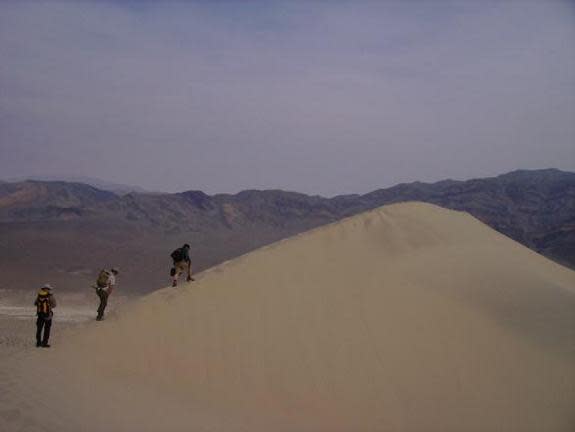Why Do Sand Dune Avalanches Boom, Burp and Sing?
Avalanching dunes can create their own music, when toppling sand erupts first with staccato burps and then with monotone "singing" booms. These tunes have long intrigued scientists, and now a team of physicists has deciphered why they occur.
The booming and burping sounds each correspond to different classes of waves within the sand dune, they found.
During the investigation, researchers visited Eureka Dunes in Death Valley and Dumont Dunes in the Mojave Desert — or what the researchers called the "very hot and sandy dunes in California" — for a total of 25 summer days, study lead researcher Nathalie Vriend said in a statement. Vriend completed the research while a doctoral student at the California Institute of Technology in Pasadena, but now is a research fellow in the Department of Applied Mathematics and Theoretical Physics at the University of Cambridge in England. [Mystery Of Singing Sand Dunes Solved | Video]
"Booming sand dunes are able to produce a persistent, low-frequency sound that resembles a pure note from a music instrument," Vriend told Live Science. "The sound has a dominant audible frequency between a D and G sharp in the second octave below middle C, and several higher harmonics that may be heard from distances far away and may last for minutes."
The researchers "probed [the] booming dunes, and they slowly revealed their underlying physics to us," Vriend said.
The team analyzed how the burping and booming sounds traveled through the sand, and measured "the motion of grains and frequency and energy of the emitted sound," Vriend said. "This, in turn, revealed that booming and burping are two different, but related, phenomena."
The short-pulsed burps are the result of Rayleigh waves (or surface waves) that traveled through the upper part of the dunes at a slower clip than the faster P waves (or seismic body waves) that created the sustained booming noises, the researchers found.
Measuring the sound waves was no easy feat. They used geophones to record the seismic vibrations within the ground, which is similar to how a microphone picks up acoustical vibrations in the air, she said.
"The waves traveling through the dune move individual grains of sand, which exert a force on the geophone that we use for measurements," Vriend said.
Moreover, the burping sounds tend to have a lower frequency of about 76 hertz, whereas the booms are sharply defined at a higher frequency of about 85 hertz, the researchers said. As the dune settles into its monotone "song," it usually emits frequencies ranging from 70 to 105 hertz, with some higher harmonics, the researchers said.
During their research, the team found that they could trigger the dune's natural resonance.
"A blow of a hammer on a plate triggered a natural resonance — around the booming frequency — inside the dune, which is something we've never seen described in literature," Vriend said.
She called the experience of creating desert music "out of this world."
"It feels like your whole body starts to vibrate," she said. "It is really difficult to comprehend that such a small and thin avalanche creates such a loud sound that booms over the desert floor."
The findings were detailed online Oct. 27 in the journal Physics of Fluids.
Follow Laura Geggel on Twitter @LauraGeggel. Follow Live Science @livescience, Facebook & Google+. Original article on Live Science.
Copyright 2015 LiveScience, a Purch company. All rights reserved. This material may not be published, broadcast, rewritten or redistributed.




